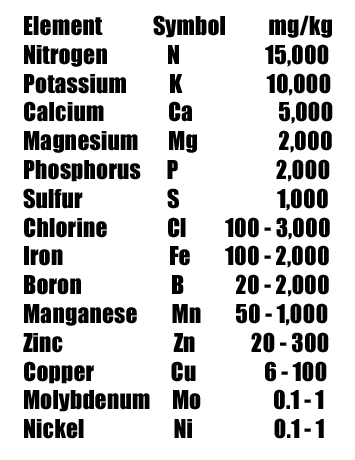Understanding plant nutrition
(Macronutrients and Micronutrients critical for plant development)
Some plant species may have slightly different needs,
but this chart represents a general average.

Nitrogen, Potassium, Calcium, Magnesium, and Phosphorous represent the 5 macronutrients (used in higher concentrations), and the rest are micronutrients, or trace elements, critical for healthy plants.
Calcium and Magnesium level in most soils is generally sufficient for most plants. This is why conventional fertilizers contain Nitrogen, Potassium, and Phosphorus clearly labeled with the percentage of each. A fertilizer marked "5 - 10 - 10" contains 5% N, 10% P, and 10% K.
Organic sources for Macronutrients:
Nitrogen - Composted animal manure, blood meal, feather meal, fish meal, crab meal, and shrimp meal
Potassium - Citrus peals buried in soil near plants, wood ash from hard woods, kelp meal, and seaweed
Phosphorous - Bone meal, rock phosphate, banana peals, shrimp shells, and composted animal manure
Calcium - Gypsum, lime, egg shells, shell meal
Magnesium - Composted animal manure
There's more to plant nutrition than loading your soil up with nutrients. Soil pH must be taken into consideration. Some nutrients will not be taken up by the plant at certain pH ranges. Also, an overabundance of one nutrient might prevent the uptake of another nutrient as well. Some nutrients depend on each other to be available to the plant. I'll cover these aspects in future posts.
so you say you like math...